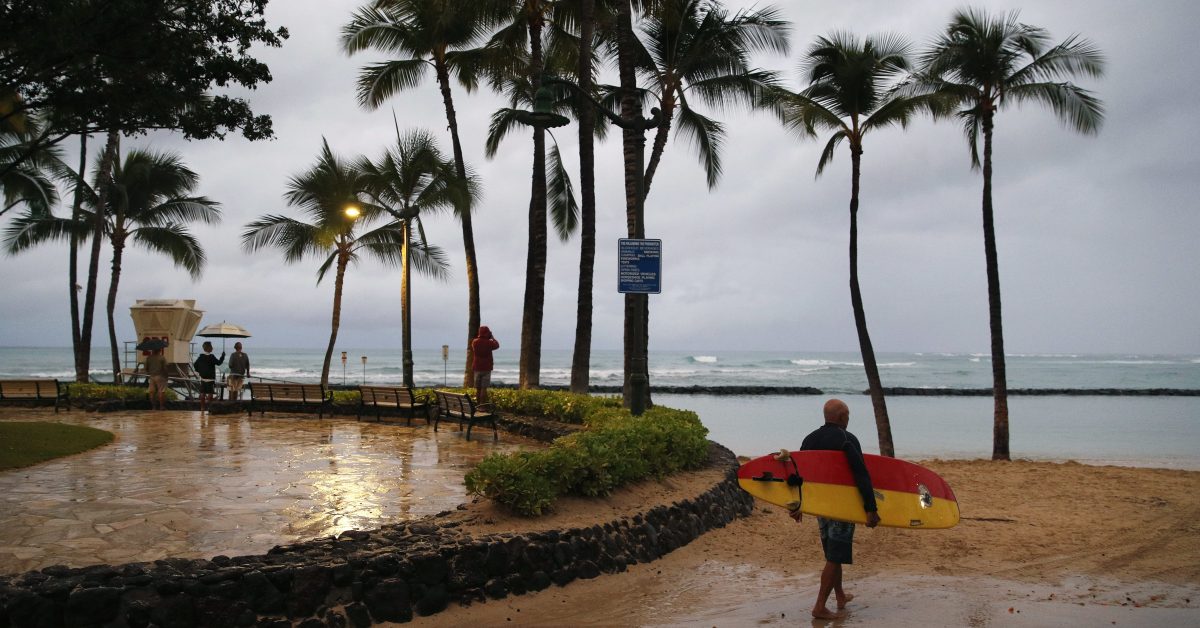
'Almost Biblical Proportions:' Big Island's Hilo Covered in Waist-High Water
A once-powerful hurricane twisted and drifted away from Hawaii, leaving behind heavily saturated ground on the Big Island and many residents on other islands relieved it didn’t wreak more havoc.
Firefighters on the Big Island rescued 39 people from floodwaters Friday through early Saturday as the island grappled with the nearly 4 feet of rain from Tropical Storm Lane, formerly Hurricane Lane, dumped on the eastern part of the island over the course of three days.
In Honolulu, where the storm deposited only a few inches of rain, shopkeepers removed plywood from their windows and reopened for business.
The National Weather Service canceled all storm warnings for the state.
Preliminary figures from the weather service show that Lane dropped the fourth-highest amount of rain for a hurricane to hit the United States since 1950. Hurricane Harvey, which devastated Texas a year ago, topped the list.
The storm’s outer bands dumped as much as 45 inches on the mostly rural Big Island, measurements showed. The main town of Hilo, population 43,000, was flooded Friday with waist-high water.
“It was almost biblical proportions,” said Kai Kahele, a state senator who represents Hilo. The ground was soggy on Saturday, he said, and it was still raining.
But Hilo is accustomed to rain, he noted. And the Wailuku River, which raged with runoff, has a name that means “destructive water” in Hawaiian. Native Hawaiians who have lived in the area for hundreds of years know how dangerous the river can be, Kahele said.
Hawaii County Civil Defense spokeswoman Kelly Wooten said teams were assessing damage but continued to focus on recovery efforts because of the ongoing precipitation.
Big Island Book Buyers in Hilo opened as normal Saturday morning after owner Mary Bicknell saw a bit of sunshine.
“Everybody is in pretty good spirits. It’s kind of nice,” she said of her customers before adding everyone was “hoping and praying it’s over.”
One of the island’s volcanoes is erupting, and the rain could still cause whiteout conditions on some active lava fields when it hits the molten rock and boils off as steam.
About 200 miles and several islands to the northwest, tourists on the island of Oahu wandered Waikiki Beach and took leisurely swims as shopkeepers prepared to reopen.
Hotels began putting deck chairs back alongside pools. Dozens of surfers were in the Pacific, looking to ride small waves. The breeze was light.
Winds were also calmer on Maui, which had seen about 12 inches of rain and wind gusts up to 50 mph. On Saturday, winds were about 11 mph. Like the Big Island, Maui experienced flooding and landslides.
Lane first approached the islands earlier this week as a Category 5 hurricane, meaning it was likely to cause catastrophic damage with winds of 157 mph or above. But upper-level winds known as shear swiftly tore the storm apart.
As flooding hit the Big Island, winds fanned brush fires that had broken out in dry areas of Maui and Oahu. Some residents in a shelter on Maui had to flee flames, and another fire forced people from their homes.
Flames burned nine homes in the historic coastal town of Lahaina and forced 600 people to evacuate, Maui County spokeswoman Lynn Araki-Regan said. Some have returned, but many have not because much of the area lacks power, Araki-Regan said.
Those outages meant the water provider on Maui’s west side was unable to pump, so officials at the Maui Electric utility urged conservation — particularly important because firefighters need supplies to put out the remaining flames.
The central Pacific gets fewer hurricanes than other regions, with only about four or five named storms a year. Hawaii rarely gets hit. The last major storm to hit was Iniki in 1992. Others have come close in recent years.
“It’s great that it didn’t get us,” Nick Palumbo II, who lives and owns a surf shop on the island of Lanai, said of Lane.
He worried, however, that the near-miss would give residents a false sense of security.
“We’re going to get nailed one time, and people are going to not listen,” Palumbo said, “exactly like ‘The Boy Who Cried Wolf.'”
The Western Journal has reviewed this Associated Press story and may have altered it prior to publication to ensure that it meets our editorial standards.
Truth and Accuracy
We are committed to truth and accuracy in all of our journalism. Read our editorial standards.
Advertise with The Western Journal and reach millions of highly engaged readers, while supporting our work. Advertise Today.











